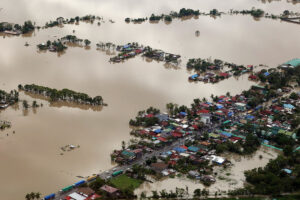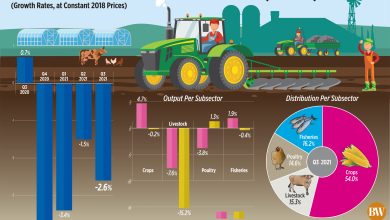Agricultural damage from Karding reaches almost P2B, infrastructure at P135M

AGRICULTURAL damage from Typhoon Noru, locally named Karding, has risen to P1.97 billion as of Wednesday, according to the Department of Agriculture (DA).
In its latest bulletin, the DA reported that the storm hit 148,091 hectares of farm lands, affecting some 88,520 farmers and fisherfolk, with a combined volume of production loss at 114,446 metric tons (MT).
Damage and losses were mainly in the Cordillera Administrative Region, Ilocos, Cagayan Valley, Central Luzon, Calabarzon, and Bicol.
Rice was the most affected commodity with reported damage amounting to P1.61 billion and a volume loss of 105,154 MT.
This was followed by high-value crops at P271.6 million; corn at P43.1 million; fisheries at P41.8 million; and livestock and poultry at P7.3 million.
In infrastructure, the Department of Public Works and Highways reported on Wednesday that damage estimates stood at P135.09 million, covering national roads, bridges, and flood-control structures.
“The reported cost will be subject to field validation,” it said.
The Central Luzon Region suffered the biggest damage at P91.38 million, followed by Cordillera at 19.6 million. Cagayan Valley had P9.11 million and Mimaropa, P3 million. Damage were also reported in Western Visayas with an estimated cost of ₱12 million.
DEPARTMENTMeanwhile, Albay Rep. Jose Ma. Clemente S. Salceda on Wednesday renewed his push for the creation of a department on disaster resilience with a Cabinet-level head.
“The NDRRMC (National Disaster Risk Reduction and Management Council) is a council, they only meet when (disasters) happen, so if nothing is going on they don’t convene,” Mr. Salceda said during the Kapihan sa Manila Bay forum.
House Bill 48, or the Disaster Resilience Act, seeks to establish an agency that will implement a permanent, institutionalized, cohesive and comprehensive framework for disaster preparedness.
“We will empower the NDRRMC so that it is no longer just a collegial or coordinating body, but an implementing agency, with cabinet rank for the head, and under the (Office of the President),” Mr. Salceda told BusinessWorld in a Viber message.
He said the establishment of the department would need “little to no incremental budget.”
During the 18th Congress, a similar measure was approved by the House on third reading but its counterpart bill did not hurdle the Senate as several legislators questioned its practicality and the funding required to set up a new department.
Mr. Salceda also said the proposed Department of Disaster Resilience can handle the training of rescue workers and the procurement of equipment throughout the year.
“The difference with the NDRRMC is that it will have the capacity for continuous training and development, the mandate to implement disaster risk reduction, mobilize resources more readily, bring decisions to the highest level of governance immediately, and summon or call on exogenous resources towards disaster-affected areas,” he said.
He added it was important to build capacities to protect the general public as well as emergency responders.
Eight people have been reported to have died at the height of Karding’s onslaught, including five rescue workers in Bulacan who were trying to reach residents trapped by flooding, according to the NDRRMC’s latest update. Five people are still missing. — Luisa Maria Jacinta C. Jocson and Matthew Carl L. Montecillo




